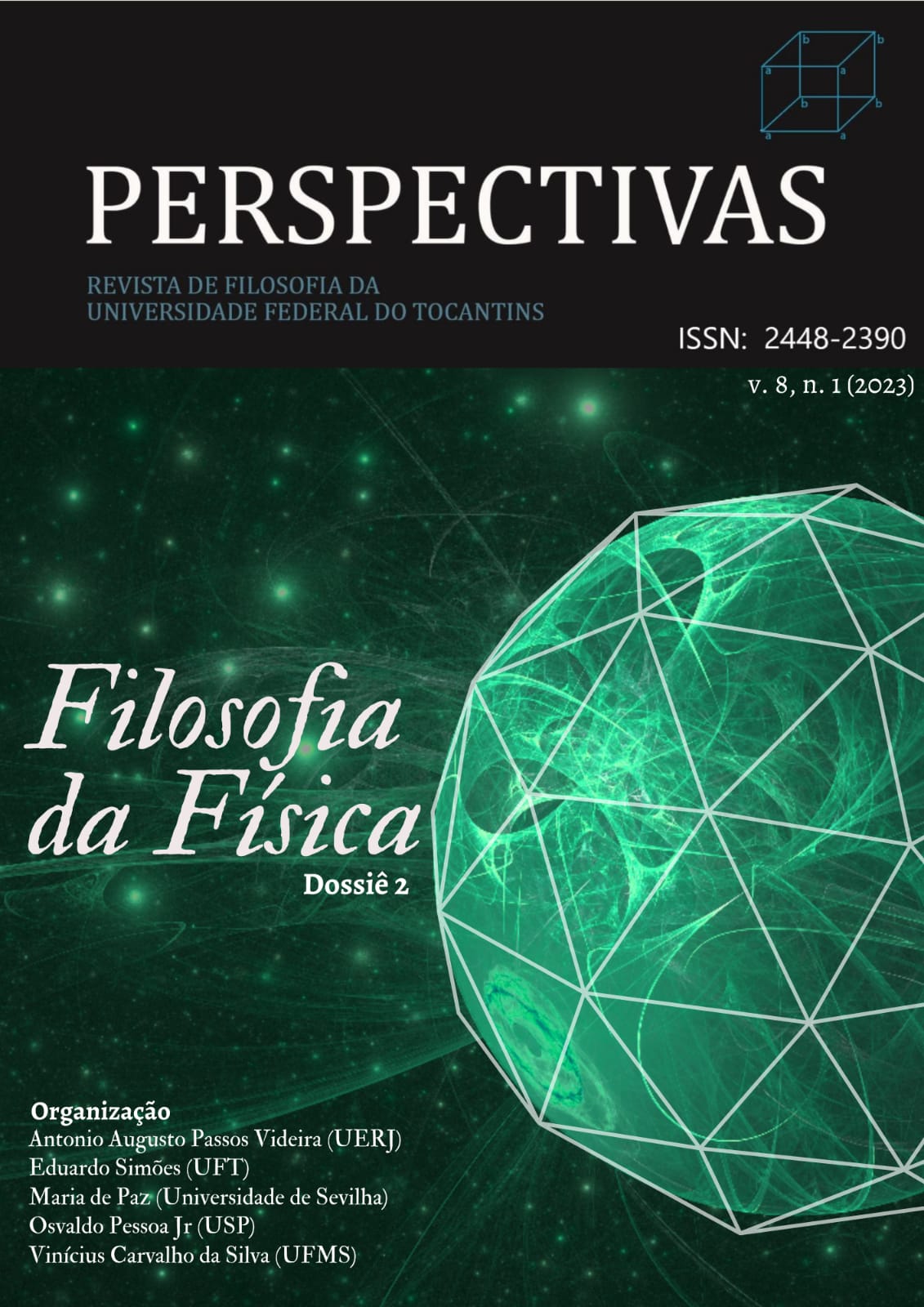A ambígua visão do mundo de Galileu
DOI:
https://doi.org/10.20873/rpv8n1-59Abstract
This work aims to achieve two objectives: the first is to report to the Brasilian culture a recent historiographical contribution on the “ambiguous vision” of matter in Galileo; the second is to develop some philosophical reflections from the suggestions present in the imaginary of the great Italian scientist. On the one hand we will breach the conventional interpretation of the Galileo mechanism; on the other hand, we will propose a hermeneutic operation to update the speculative imagination of a father of the scientific revolution of the seventeenth century by comparing it with Alfred North Whitehead's philosophy of organism - who proposed his doctrine as alternative to materialistic mechanism -, and the “eurhythmics physics” or “physic of becoming”, defended by José N. R. Croca and his research group. In fact Galileo, in his reform of the scholastic image of the world, faced the paradox of reconciliation mathematical continue with physical atomism, sketching an unusual “emergentist solution”. Uncover the metaphysical horizon of Galileo's thought provide us an new historical and philosophical access to the most controversial issues of modern philosophy of science and quantum mechanics.
References
ACCETTO, T. Della dissimulazione onesta, Genova: Costa & Nolan, 1983 (1641).
BUCCIANTINI, M. Galileo e Keplero: filosofia, cosmologia e teologia nell'Età della Controriforma, Torino:
Einaudi, 2003.
CLAVELIN, M. Le Copernicanisme padouan de Galilée, em Galileo a Padova, 1592-1610, Trieste: Edizioni Lint,
voll., 1995.
_______. Galilée copernicien: le premier combat, 1610-1616, Paris: A. Michel, 2004.
PERSPECTIVAS | VOL. 8, Nº 1, 2023, P. 19-42
A ambígua visão do mundo de Galileu
DOI: 10.20873/rpv8n1-59
CROCA, J. R., ARAÚJO, J. E. F. (ed.). A New Vision on PHYSIS. Eurhythmy, Emergence and Nonlinearity, Lisboa:
Centro de Filosofia da Ciência da Universidade de Lisboa, 2010.
_______. ALVES, P., GATTA, M. (eds.). Space, Time, and Becoming, Lisboa: CFCUL, 2013.
_______. Beyond Space and Chronological Time. The Physics of Becoming, Berlin: Lambert Academic Publishing,
FAVARO, A. (ed.). Opere di Galileo Galilei, Firenze: Barbèra, 20 voll., 1890-1909.
FEDERICI, S. Calibã e a bruxa: Mulheres, corpo e acumulação primitiva, São Paulo: Editora Elefante, 2017.
GALILEI, G. De motu antiquiora; em Favaro A. (ed.), Opere di Galileo Galilei, vol. I., pp. 243-417.
_______. Discorso intorno alle cose che stanno in su l'acqua; em Favaro A. (ed.), Opere di Galileo Galilei, vol. IV,
pp. 17-141.
_______. Risposta alle opposizioni del S. Lodovico delle Colombe e del S. Vincenzio di Grazia contro al Trattato del
Sig. Galilei; em Favaro A. (ed.), Opere di Galileo Galilei, vol. V, pp. 449-789.
_______. Il Saggiatore nel quale con bilancia esquisista e giusta si ponderano le cose contenute nella «Libra
Astronomica» di Lotario Sarsi Sigensano; em Favaro A. (ed.), Opere di Galileo Galilei, vol. VI, pp. 197-
_______. Dialogo sopra i due massimi sistemi del mondo; em Favaro A. (ed.), Opere di Galileo Galilei, vol. VII, pp.
-520.
_______. Esercitazioni filosofiche di D. Antonio Rocco, em Favaro A. (ed.), Opere di Galileo Galilei, vol. VII, p. 745.
_______. Discorsi e dimostrazioni matematiche intorno a due nuove scienze attenenti alla meccanica e i
movimenti locali; em Favaro A. (ed.), Opere di Galileo Galilei, vol. VIII, pp. 9-318.
GALLUZZI, P. Galileo contro Copernico. Il dibattito sulla prova “galileiana” di G. B. Riccioli contro il moto della
Terra alla luce di nuovi documenti, em «Annali dell'Istituto e Museo di Storia della Scienza di Firenze,
II, 1977, pp. 87-148.
_______. Momento. Studi Galileiani, Roma, Dell'Ateneo, 1979.
_______. Tra atomi e indivisibili. La materia ambigua di Galileo, Firenze: Leo S. Olschki Editore, 2011.
KOIRÉ, A. Etudes galiléenes, Paris: Hermann, 1939.
MAZZOLA, A. La controversia sulla teoria dei quanti e la scuola di Lisbona, «Physis», Casa Editrice Olschki de
Firenze por conta da Domus Galilæeana de Pisa, Vol. 50, n. 1-2, 2015.
_______. “Il manifesto di Lisbona: fisica quantistica e filosofia della natura”, in «Rocinante, Rivista di filosofia
iberica, iberoamericana e interculturale» (ISSN 2531-6451), n. 9, December 2016, pp. 77-86.
_______. “Solidariedade do universo e evolução emergente na cosmologia de Whitehead e na Física
Eurítmica”, in J.R. Croca, M. Gatta and P. Castro, Eds. Euritmia, Complexidade e Racionalidade numa
Perspectiva Interdisciplinar, CFCUL, Lisboa, 2017, pp. 99-123.
_______. “Whitehead and Eurhythmic Becoming. The Forgotten Ontology of Rhythms”, Noema, n. 11, 2020a,
pp. 91-118.
_______. “O realismo orgânico de A. N. Whitehead e a dádiva da tradição”, em Pombo, O. (org.) Ciência,
Racionalidade e Politica. Ensaios (in)atuais, Aletheia, Óbidos 2020b, pp. 238-258.
_______. Ecstăsis Naturae. O valor euritmico do devir natural: Alfred North Whitehead e a Escola de
Lisboa, Roma: Aracne, 2022.
MEREU, I. Storia dell'intolleranza in Europa, Milano: Bompiani 2000.
PERSPECTIVAS | VOL. 8, Nº 1, 2023, P. 19-42
A ambígua visão do mundo de Galileu
DOI: 10.20873/rpv8n1-59
PETERS, F. E. Termos Filosóficos Gregos. Um léxico histórico, Lisboa: Fundação Calouste Gulbenkian, 1974.
REDONDI, P. Galileo eretico, Torino: Einaudi, 1983.
_______. Atomi, indivisibili e dogma, em «Quaderni Storici», XX,1985, pp. 529-571.
WHITEHEAD, A. N. Science and Modern World, Cambridge: Cambridge University Press, 2011 (1925).
_______. Process and Reality. An Essay in Cosmology, New York: The Free Press, 1978 (1929).
Downloads
Published
How to Cite
Issue
Section
License
Copyright (c) 2023 Andrea Mazzola

This work is licensed under a Creative Commons Attribution 4.0 International License.
The Magazine is under the Creative Commons Attribution 4.0 International Public License (CC BY 4.0), according to which:
1) The authors retain the copyright and grant the journal the right of first publication, with the work simultaneously licensed under the Creative Commons Attribution which allows the sharing of articles published with the recognition of authorship and initial publication in this journal.
2) Authors are authorized to enter into additional contracts separately for distribution of the version of the work published in this journal, as long as there is recognition of authorship and initial publication in Perspectivas.
3) Authors are authorized and encouraged to disseminate published texts with proper references to the journal and its authors.





















